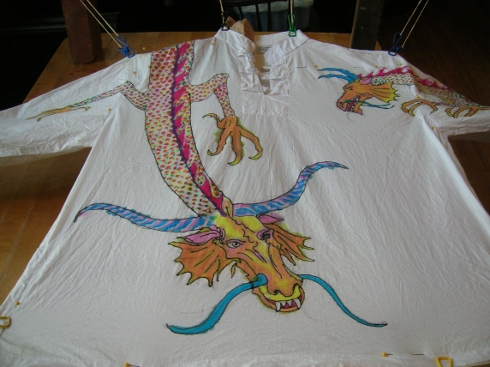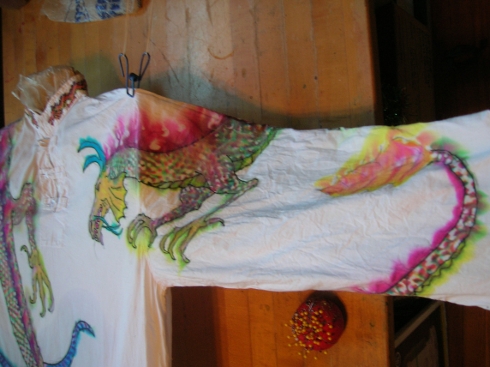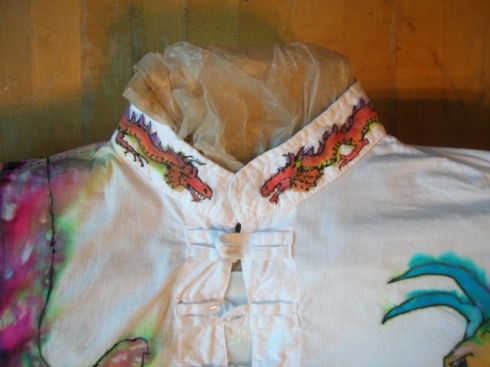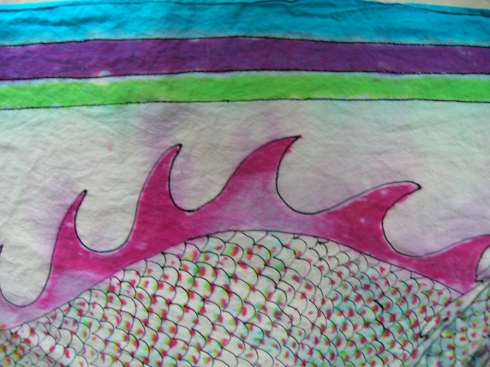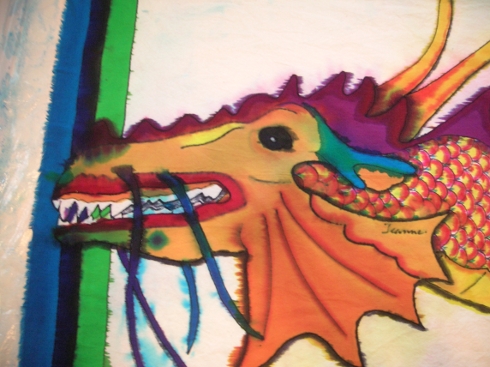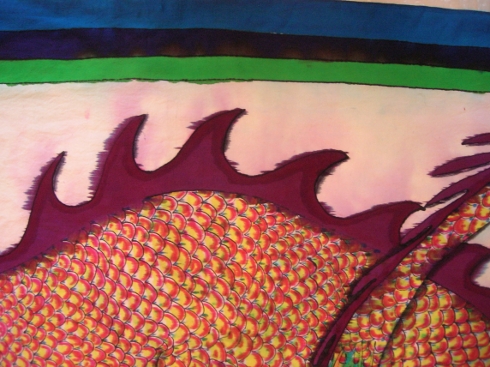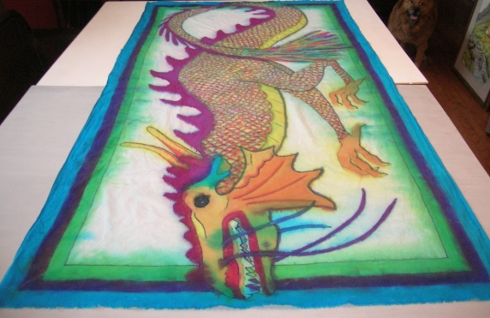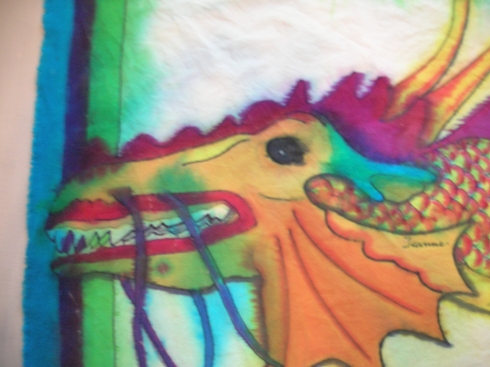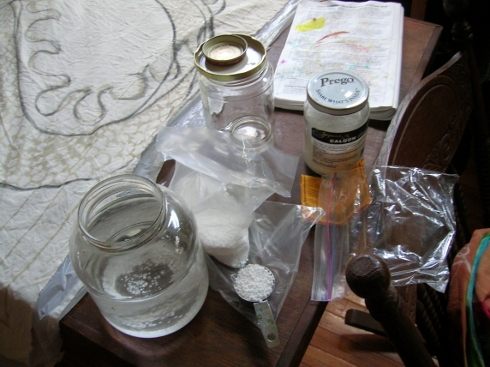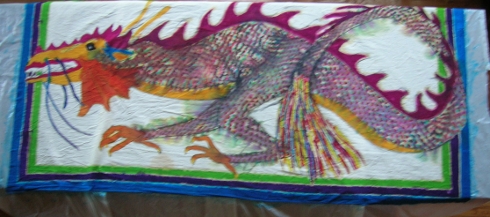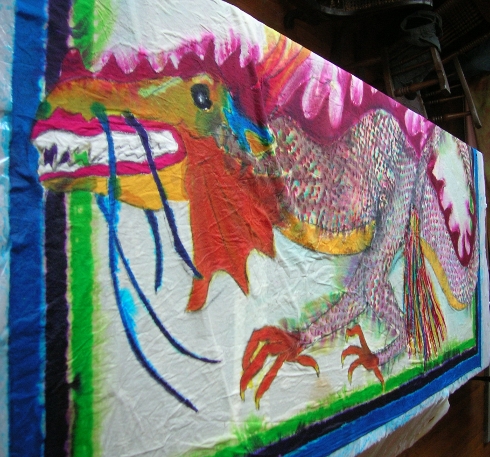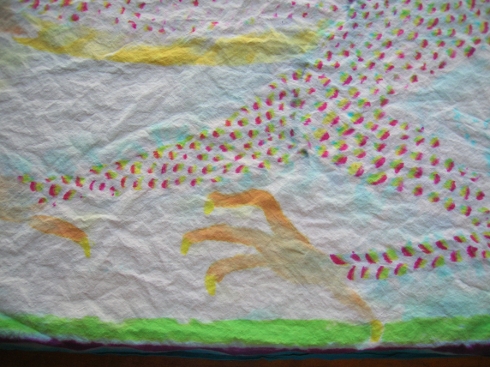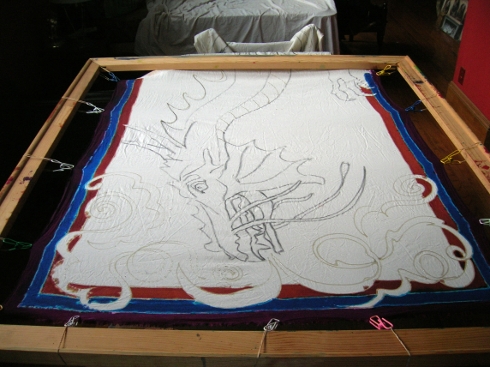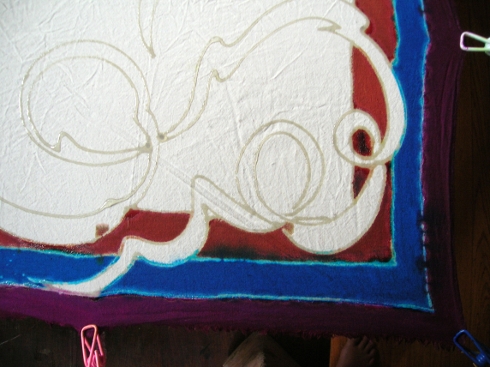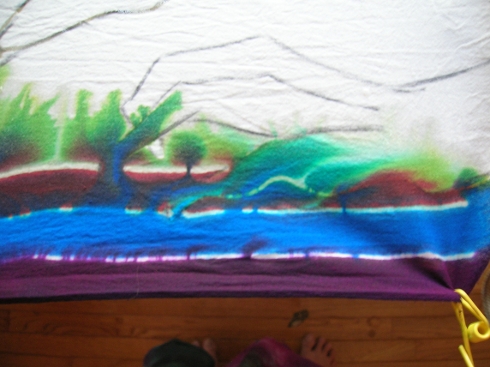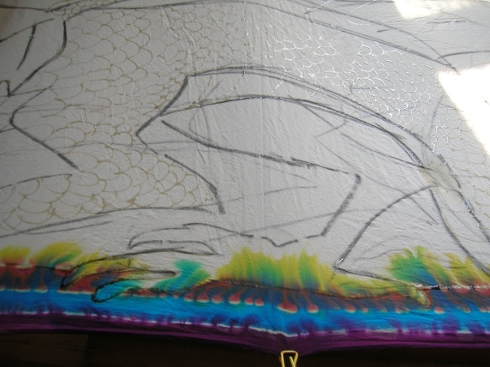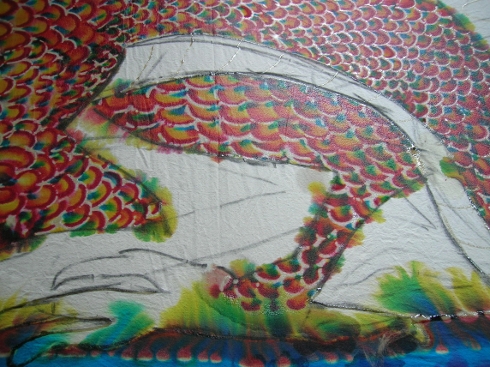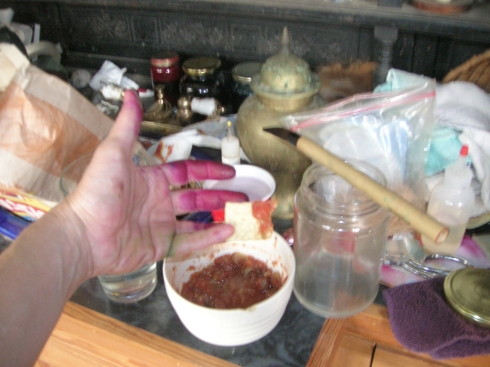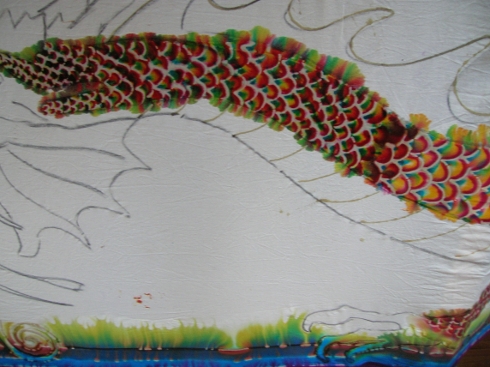before we start, i just want to jot down what i’ve accomplished between completing my dolphin commission and starting my sari project. i’ve had a whole bunch of stuff on hold ever since i started working on dolphins, right after getting back from a long residency, so really, on hold since last september. so i’ve got a lot of bits and pieces still in the pipeline, and a whole bunch of new things that have just fallen in my lap – and a couple of neckties too!
i finally finished a set of quilted pillow covers for my friend marlene. this is stuff that’s been sitting on the sewing machine for months. i didn’t bother documenting it, mostly because the camera was in the studio and i did it over such a long period. it was strip-pieced out of two fat quarters i picked up in holland – of cats, marlene’s favorite subject. i got another fat quarter of a completely different color scheme in decatur, and then harmonized it with a length of fabric i found in my stash. then invented a modified box pillow structure (because i didn’t follow directions for either flat or box pillow but added the strip around the side as an afterthought).
i spent several hours cataloging and photographing my 38 new saris, several of which are wearable. now i can go to my biggest customer (my sister) and she can pick out which of these lovely lengths of silk she wants me to make her a strip-pieced kimono out of. and i can go to friends with offers of silk rags.
i’ve got a tunic and pants that i made and hand-dyed several years ago soaking in a brown overdye bath, waiting to go into the washing machine. and, next morning, they’re being washed now.
—
so, to the project. i’ve been getting into saris lately. i’m tired of wearing sweatpants and a t-shirt. i hate most clothes because they weren’t made for me, and i have an oddly shaped body that doesn’t look good in conventional clothes, and so i either slink around in shapeless black or i say fuck it and dress the way i want to. which is basically to wrap a rag around myself. a towel. a robe. it can be a colorful rag. i’m actually quite happy wrapping myself in some of my fabrics. i’ve been known to confiscate a nice piece of portrait linen to use as a skirt.
anyway, first i tore up a bedsheet that had seen its last use, and dyed it a nice green/blue/purple, tore it into 2-yard lengths, and started learning how to wrap sarongs, or kangas. skirts and tops, endlessly. then i went to the indian part of town and got myself a 4-yard dhoti, dyed that basically the same way, and started learning how to wrap pants on myself the indian way.
i bought a couple of saris from someone who goes to india and brings them back to sell. they were my xmas present to me. and i practiced with my book and my mirror every day. i don’t usually stand in front of mirrors; sweatpants don’t take that much fuss. but if you’re trying to put on a sari from minimal directions then a mirror is essential.
as it got warmer, i started changing out of my sari right after the dog walk. i wasn’t draping it too well in the beginning, and it would trip me up, or fall right apart while i was out in the neighborhood. and it was a big deal not catching my foot in my pants hem and tripping myself going up stairs. but i’ve been wearing lengths of cloth around my body for almost four months now, and don’t often wear anything else. mostly, since it’s hot, i wear my kanga/sarong length cloths, one as a shirt, one as a skirt, and i’m folding the skirt in half so it’s short. in the evenings and morning i change into a sari, using the book, and move uncomfortably while adjusting it constantly.
but i’m getting the hang of it. i can put on a 4-yard dhoti as a pair of pants in no time flat, and can do it several ways. and if i put on pants using a 6-yard sari, then i can usually figure out what to do with the two yards at the end.
i’m still flummoxed by most styles of wearing the sari, however. it looks great on the model and in the drawing, but on me it looks like a badly wrapped package. but as i’m getting used to it, each different style of wrapping 6 yards of cloth is beginning to make more sense.
which is good, because i’ve just invested in 10 kg of used silk saris, and some of them are actually wearable.
after all, if you look at it, you can knot any corner against any other, so that’s 8 ways to tie it, plus all sorts of ways to knot the middle parts together. it all makes sense, but it takes time to figure out just how. i’ll just keep putting on lengths of cloth in front of mirrors, and i’ll eventually stop looking like a dork.
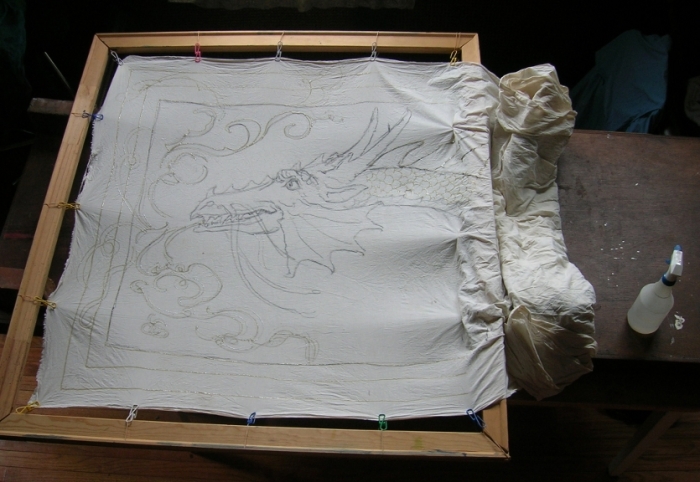
jim drew me one of his wonderful dragons, 6 yards long. he used charcoal. i had ordered six yards of muslin, prewashed it, and soaked the whole length in a soda ash solution (1 cup per gallon). then when that dried, i stretched it using spring clips. it was way wrinkled, so i spritzed it with water and let it dry under the fans. the stretcher is 48″x 45″, so it only takes a little more than a yard at a time. that was a big consideration. it meant a lot of thinking about how i was going to do this.
i’ve done silk pieces of a size before. i did a 3 yard veil for my friend asha. but i haven’t worked on cotton in any size except a test strip. so all that follows is first of all guesswork and only secondarily experience and knowledge of my materials.
i frankly don’t know what i’m doing with this method of dyeing. i’m familiar with silk dyeing, have been doing it for ten years, and still make loads of mistakes, still have colors completely wash out on me. but on cotton, and doing direct application on cotton, and using the soda soak method – permeating the fabric with soda ash instead of putting the soda ash into the dye liquid, which shortens the life of the dyes, and i don’t paint quickly so that’s not going to work for me. if i put the ash into the fabric, then i can let it sit for however long i need to until i’m finished with my project. which was several weeks. if i’d set silk there for several weeks with soda ash all over it, the silk would fall apart when i picked it up. cotton reacts differently, but nobody could tell me how long i could keep cotton and caustic soda together before it ate thru the fabric. so this is partially an experiment to see how well the cotton lasts. it was maybe three weeks sitting on a shelf after having been soaked in soda ash and not rinsed. so we’ll see.
my big issue with 28 feet of fabric is dyeing the background. since it has to be dyed in pieces, i’m going to be having edges at the edge of every day’s progress. and the color of the dyes changes from day to day, as well as the thickness and the impurities, and maybe even the water itself ages who knows.
the way i understand this direct method of painting is that you’re supposed to paint it and then keep it damp until the chemical reaction sets the dye. this is like from an hour to a day of keeping the fabric damp. but with painting over a square yard at a time, in an open room, in the middle of summer, with the overhead fan on, is that the damned thing dries as you’re painting it. so my plan was to paint it, let it dry, and then at the end of every day’s work, get it damp, roll it up in plastic, and let it cure until the next morning.
why i didn’t realize i could wait until the end and then do the batching, i don’t know. possibly because it would take 6 yards of plastic bags to do it that way, and the way i did it only took 4 bags. it was a real pain in the ass batching one section of a continuous length of fabric at a time, tho. the edges bled right out into the following day’s workspace, the yellow travelling fastest.
according to this method of dyeing, soda soaking followed by direct application, according to the way soda ash and procion dyes supposedly react, the moment the dye touches the ash, it becomes bonded to the fabric, and when there’s no more soda ash to bond, then the dye ceases to stick to the fabric and will wash off as excess dye.
but i wasn’t seeing it when i spritzed my work at the end of the day, right before rolling it into the plastic bags. it ran like anything when the water got on it. but maybe it didn’t. maybe it was just excess dye running off, not going to stick to anything because the bonding had already happened. maybe i needn’t have batched anything, because maybe the very laying down of dye over the fabric and soda ash was enough to bond it. if that was the case, then i wouldn’t be able to do the kind of blending and bleeding i was looking forward to. oh, it would run all right, but it would wash right out of the finished product. maybe. so here was another experiment. how well does the dye go on and how well can it be moved, when does it set, and how much difference does it make when i set it.
this sari-length (about three inches, goes the punchline) cotton fabric is just the first part of this project. when i’m done with the six-yard dragon, i’m going to take the other six yards i bought of a slightly narrower muslin, cut it into a four-yard length and a two-yard length, and make two more dragons. i’ll apply what i’ve learned doing the large dragon to the middle one (like not batching it until the end), and then apply what i learn from that to the small one, and that one will turn out just right. and my sister will get the small one. as a sarong. she’d be intimidated by a sari, but she’ll love the sarong.
so. back to the project.
i made up a batch of sodium alginate into a water-based resist, and put that into a squeeze bottle, and then put a mess of karo syrup into another squeeze bottle. then i went over jim’s drawing with a bead of sodium alginate. of the two, it’s the stronger resist. i use the syrup because it dissolves fast. it goes gummy and travels when it gets wet, and makes great runs of one dye into another. i use the syrup to draw the scales and the crest. and i used syrup on the border, where i made lines for three stripes of color.
this is all the stuff i worked with. i’ll run off the list. from left to right in the back, the spritz bottle of water, the karo syrup in a squeeze bottle, a baggie of urea, a corroded mason jar of soda ash, a bottle with sodium alginate powder in it, a cup measure with a teal lid holding the batch of sodium alginate i mixed up using this recipe, then another squeeze bottle with sodium alginate in it.
on the front row is a jar with urea water, for thinning the dyes, then the bottles of dye powder in back and the bottles of mixed-up dye in front, then spoons and brushes and measuring instruments. i made up the dye using one 1/8 cup scoop of dye powder into a jar, pasted up with urea water (1/8c to 1 cup hot water), and filled to about the 6 oz mark (more or less; i’m a terrible chemist). these are all the things i need to decorate my sari.

below is the end of my first day’s painting work. as you can see by the drops on the floor, i’ve lined the table underneath the cloth with cut-open plastic garbage bags, and have already wetted the painting to make the dyes run. i’ve taken it off the stretchers (you can see the edge of the stretcher at the top of the picture, and the bricks it was resting on to the left). i’ve tried to make the transition from dyed area to white area soft by brushing out the dye as i applied it, so that there won’t be a hard edge after it’s batched. i thoroughly wetted the painted areas, until the cloth was shiny and sopping, and dripping readily off the edges.
then i rolled it up very carefully, making sure there was plenty of overlap between bag edges. if the wet fabric is allowed to touch another piece of wet fabric, the two will bleed all over each other. by rolling the whole thing up in plastic, i’m isolating the painting from everything else, each layer surrounded by plastic.
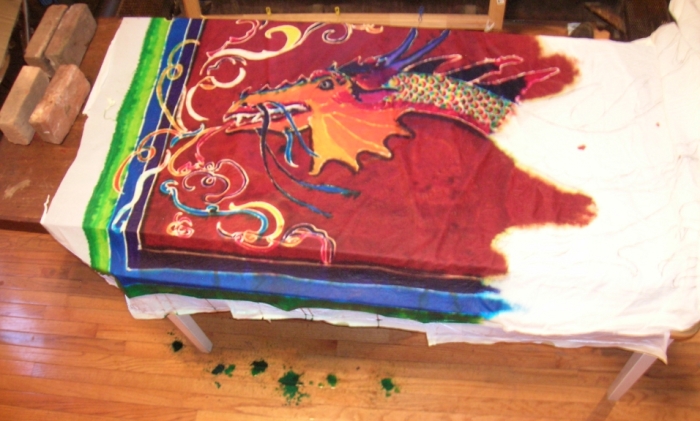
because i’m a lazy documentarian, you’re missing any possible view of what the first part looked like the next morning. it was nothing like as clear as it looked on the above picture. all that white space in the curlicues was gone, and the bleeding of the blue into the surrounding areas was horrible to behold. the scales were muddy, the background was splotchy. i didn’t want to continue.
but i did. i rolled it all away from the plastic, set it out in the morning sun to dry, and then stretched the next part of the panel. but because i’m such a slob, you’re not going to see the process photo on the second part of the panel, either. i forgot to take pictures. however, on the photo below, you can see the results of the same level of wetting the next morning as happened on the first part of the panel. see that yellow bleed? that’s how far the yellow part of the reddish brown color travels when it’s wet. and at the edge of that yellow line, there’s a crust of soda ash, redried from how far the wet crawled.
there was something strange happening every now and again. the muddy scale thing. i guess maybe i got that part a little too wet (more than sopping isn’t enough?) and maybe the colors pooled in the plastic…
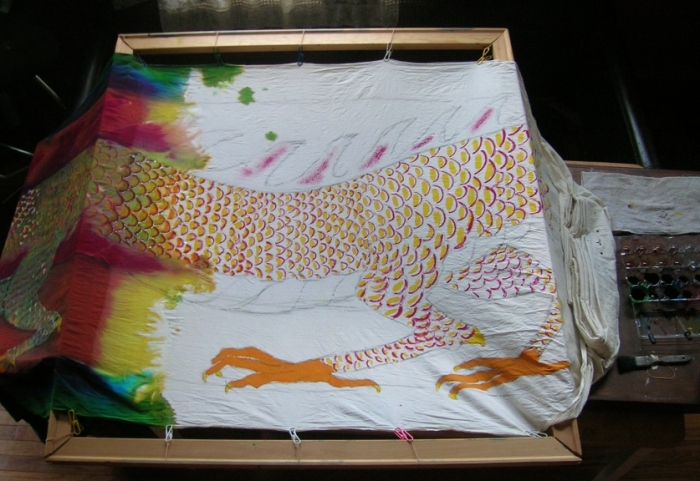
this is how it looked when i was finished for the day, and ready to wet it down and roll it up. you can see all the colors i’ve been playing with in the egg tray to the right.

then i sprayed it, a little less than i had the prior two panels, just to see what would happen, and forgot to take a picture before i rolled it up. but here’s a picture of the roll. i let it sit there all night, and then rolled it out and let it air dry, and started on the next part. it took five days of this, and on the sixth day, i did the laundry.

here’s the start of the 4th day’s work. the tail is crossing the body here, and you can see the long straight alginate resist lines outlining the body, and the shiny scales made out of karo syrup. as the alginate resist dries, it goes clear, and you can only feel it with a finger. the sugar syrup dries too, but stays sticky and shiny, and you can always see it. that’s why it’s okay not to draw in the lines you’re going to resist with sugar syrup, but you’d better follow the charcoal lines with the alginate resist, or you’re not going to know what to color in which color once the resist has dried. i found that out, and so there are a number of resist lines that i crossed at random, and if i were being good about this experiment i would have kept better notes…

this is the end of the painting in process on the second to last piece of the panel. it looks all smooth from a distance, but notice the extreme left side of the stretched part, where the reddish brown has a real dark edge. a couple of edges, actually. this marks the overlap between this day’s work and the previous day’s work. note on the previous day’s dragon body, where the back leg is, how obscured and cloudy it is there. and also note where the purple border at the top has run into the reddish background.

in this next shot, i’ve laid the cotton down on cut up plastic garbage bags, and sprayed it with water. you can see how it looks wet, theres a kind of glisten on the surface. and the running has started, where the dyes get wet and start to move across the weave of the fabric. it’s a great process, and fun to watch, tho it’s a little like watching water come to a boil.

hmm, no picture of the dried part after it had batched all night. so let’s move on to the final part of the panel. you can see where i left off the day before, and you can see where the background has bled, but it’s not as bad as before because i used less water to dampen the fabric before batching. but there’s still significant bleeding, especially in the scales, where they’re quite washed out looking. you can see the yellow bleed of the background on the left hand top of the scales in today’s work. you can’t see it where i’ve put reddish background, well you can but it’s subtle.
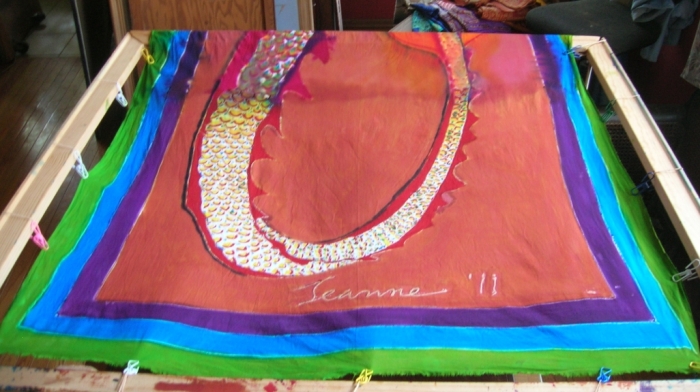
here’s a closeup. my standard scale treatment is a line of red at the outer edge near the the resist, with a line of yellow next to it, and a dot of blue at the small end. it’s a shorthand i use to represent scales, and it’s supposed to run all together and make a rainbow in every scale. on this cotton, at this large size of scale, i’m finding that there’s a lot of white space, and the colors aren’t running like i want them to do. it seems the blue just bleeds all away, and does stranger things than the other colors. because i like to strip my processes to the basics, i only use the four primary colors – yellow, magenta, cyan and black, and mix up any color i want using these four colors. and so that’s my shortcut for the scales, just more of the same and let the water mix it.

here are three plastic garbage bags, split on both sides and unfolded across my worktable. when i lay the fabric down over it, the plastic will hang down about 2″ lower than the fabric on both sides, so that i can properly seal the edges. when i roll the fabric up into the plastic, each part of the fabric will be surrounded, both by the plastic it’s lying on, and the bottom of the plastic the next part of length is lying on, as it’s rolled together. as long as there are no leaks, there’ll be no bleeding. as long as i haven’t made it too wet, as long as i don’t roll a break in the plastic overlap into it, as long as…

here’s the fabric laid out on top of the plastic. this is the next morning, after having batched all night in a little ball, wrapped in plastic. you can see all the bleeding going on. i’m pretty sure one of those large mud puddles on the scales is because there was too much water and it all bled together. but anyway, this is a case of the blue getting out from the resist around te scales, and going nuts. and there wasn’t that much blue. the purple strip on the border seems to have run away with itself, too. all in all, pretty damned ugly. but so what.

this is just another view from above on the ladder. the whole of the sari is piled on the floor to the left. and it’s finished. time to wash it out, because the whole thing has batched and it’s ready to finish in the washer.
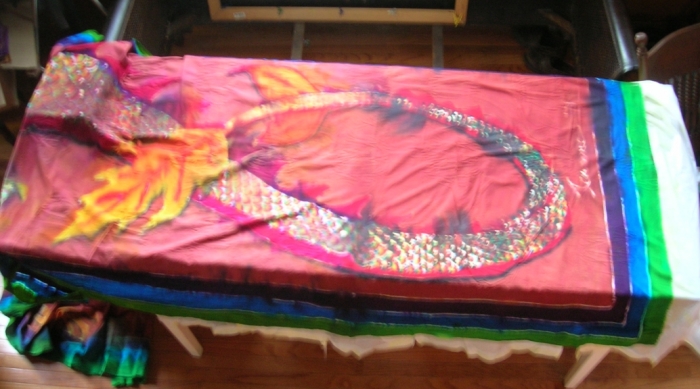
so i dragged it to the sink in the kitchen and am running cold water over it to wash out the excess dye. this takes forever, and uses many many gallons of water. very wasteful. maybe someday i’ll just use enough dye to take to the fabric, and not leave any excess to wash out.
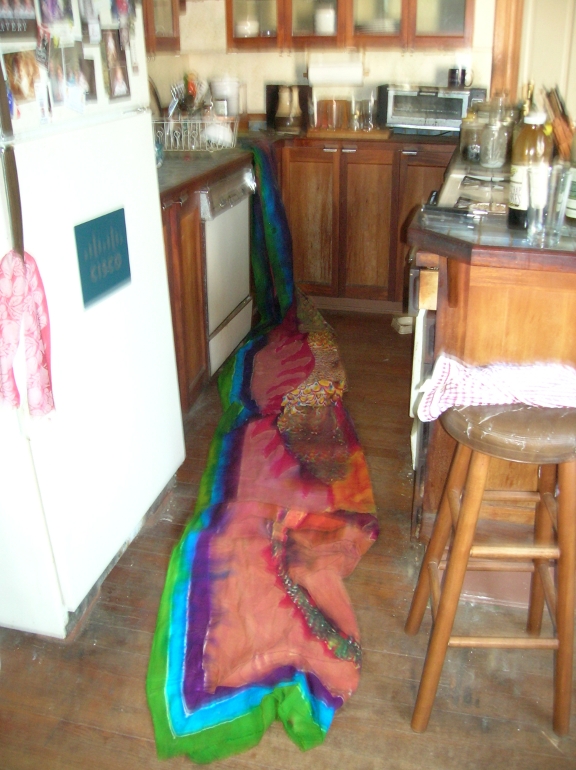
i apologize for the blur. my camera doesn’t like focusing on such things. this is the sink. i’ve gone thru the entire length of the fabric, washing out one side of it and piling it up against the far side of the sink. now i’m turning it on its side and continuing to rinse it. i’ve got it all neatly piled together because the border leaks the darkest blues and greens, and the body of the fabric leaks bright red, and i don’t want them mixing, so i’m laying the border all together as much as i can.
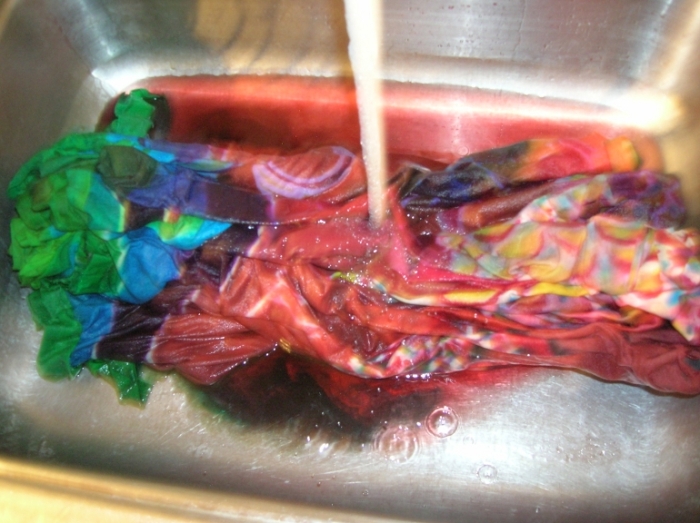
then it got washed in hot water and synthropol, or actually, the house brand that’s way stinkier but also way cheaper. industrial strength detergent. it got a wash and a rinse, and then i stuck it on a regular load with regular detergent and did it again, because it was still bleeding. this is the second rinse, and you can still see colors in the water.
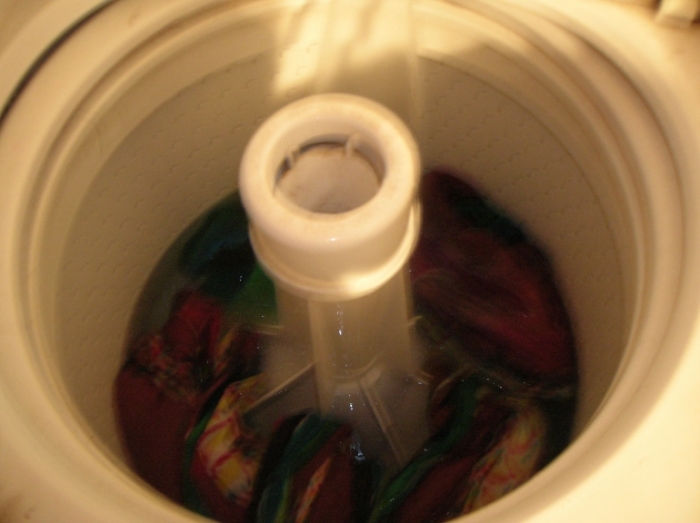
then i didn’t bother heating the room up running the drier, but hung it outside off the porch railing until it was dry.
this is it lying on the bedroom floor at full length. it was still a bit stiff, so i washed it again, and this time stuck it in the drier with the rest of the load. it’s stopped bleeding, so it’s fine to do that. but we’re not washing any whites with the load after that, just in case. my brother’s staying with us and doesn’t need pink socks.

so this is the result of direct dyeing on cotton muslin. as you can see, most of the mud washed right out. after i’d batched the front panel, for example, you couldn’t see any of the breath, it was all dark and muddy. but that didn’t take, and washed right out. so there’s something to be said for the idea that the dye sets the moment it touches the soda ash. there’s a little movement of the scale colors, possibly since they didn’t get saturated when i painted them in, but only when i spritzed them and then batched them covered. but for the most part, the colors stayed where i put them, and there’s no large-scale bleeding from the crest, or over the border lines. and those are made of sugar syrup, and are designed to move.
this means that i can’t really use the sugar syrup running technique, the way i use it on silk. because of the soda ash, i’ve got to fiigure out another way to do it. but i might be able to.
what’s next: i’ve already got the next six-yard piece lying in a bucket of soda ash and water. this evening i’m going to take it out and dry it off on the railings of the porch, and then tomorrow i’m going to cut it into two lengths, and lay the longer one over the sari. i’ll trace the dragon onto it, shortening it appropriately, and then i’ll stretch it and mix up some more sodium alginate, and some more dye, and begin again. but this time i’m going to paint the whole thing, and then batch it. that way i don’t have to worry about the background bleeding on. i’ll have to worry about encasing 4 yards in plastic, however. how many plastic bags do i have to waste?









